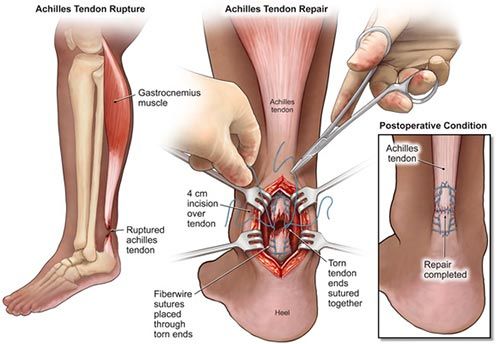Foot & Ankle
Achilles Tendon Repair
The Achilles tendon is the largest tendon in the human body, connecting the calf muscles to the heel bone. It plays a vital role in walking, running, and jumping, allowing for push-off strength and stability. When the Achilles tendon is ruptured or torn, it can cause severe pain and disability. This injury commonly occurs during sports activities, particularly with sudden, forceful push-offs.
While treatment for Achilles tendon rupture has been extensively studied, it remains somewhat controversial. However, surgery is often recommended for athletically active individuals to reduce the risk of re-rupture and to improve push-off strength.
What is Achilles Tendon Repair?
Achilles tendon repair is a surgical procedure aimed at reattaching a torn Achilles tendon. It is commonly recommended for individuals who experience a rupture or tear of the tendon, which typically happens with a sudden movement, such as a high-impact sport.
The repair process involves stitching the torn tendon back together, reinforcing it with other tendons if necessary, and reattaching it to the heel bone (calcaneus) where it may have pulled away. The aim is to restore functionality and reduce the risk of re-injury.
When is Achilles Tendon Repair Recommended?
Achilles tendon repair may be recommended for the following:
- Ruptured Achilles Tendon: Complete tear of the tendon due to forceful activities.
- Athletes: Athletes who require full recovery of function and strength to return to sports.
- Inability to Walk or Perform Daily Activities: If the tear significantly impairs walking or everyday movement.
- Failed Conservative Treatments: In cases where non-surgical methods have not provided sufficient relief or healing.
Procedure for Achilles Tendon Repair
The Achilles tendon repair procedure typically involves the following steps:
- Incision and Exposure: A small incision is made at the back of the heel to expose the torn tendon.
- Debridement and Repair: The torn tendon is stitched back together using strong sutures. In some cases, the tendon is reinforced with other tendons, depending on the extent of the injury.
- Reattachment: If the tendon has pulled away from the heel bone, the surgeon will reattach it to the calcaneus (heel bone).
- Minimally Invasive Approach: Dr. du Sart prefers minimally invasive surgery techniques, which reduce scarring, promote faster recovery, and minimise post-operative pain.

Recovery After Achilles Tendon Repair
The recovery process after Achilles tendon repair is crucial for regaining full strength and function of the ankle. The timeline for recovery depends on the extent of the injury and the patient’s overall health.
Pain Management
- Post-Surgical Care: Following surgery, your foot will be elevated to reduce swelling, and local anaesthetic will provide immediate pain relief.
- Pain Medication: During your hospital stay, you will be prescribed pain relief medications, including paracetamol and anti-inflammatories. Stronger medications may be used initially and phased out as recovery progresses.
- Ice Therapy: Applying ice packs to the area 3–4 times a day for 20 minutes will help manage swelling and reduce pain.
Mobility and Rehabilitation
- Crutches and Immobilisation: After surgery, you will use crutches to avoid full weight-bearing on the operated foot. The foot will be placed in a CAM boot with heel raises for about 10 weeks.
- Physical Therapy: A graduated rehabilitation program will begin once the incision has healed, focusing on progressive weight-bearing, range of motion, and strengthening exercises.
- Full Recovery: The rehabilitation process will be supervised by an experienced physiotherapist to ensure proper recovery. Full functional recovery typically takes 6–12 months.
Return to Work and Sports
- Return to Work: The time it takes to return to work depends on the nature of your job. Most patients should plan for at least two weeks off work for initial recovery, especially for jobs that require standing or walking. For physically demanding work, return may take 6 to 8 weeks. Athletes or individuals with jobs involving heavy lifting or overhead movements may require 3 to 6 months for full recovery.
- Sports: For high-impact sports or activities such as jogging, full recovery and return to sport may take 4 to 6 months, depending on the level of activity and the healing process.
Driving After Achilles Tendon Repair
- Return to Driving: After surgery, you may be able to drive in 2 weeks if your left ankle was operated on and you have an automatic car. However, if the surgery was on your right ankle, it is recommended to wait until 12 weeks before driving. Always discuss this with Dr. du Sart before resuming driving.
Why Choose Dr. Ryan du Sart for Achilles Tendon Repair?
Dr. Ryan du Sart is a highly trained orthopaedic surgeon specialising in foot and ankle surgery. With a comprehensive approach to Achilles tendon injuries, Dr. du Sart provides personalised care to ensure optimal recovery. His use of minimally invasive surgical techniques ensures a quicker recovery, reduced risk of complications, and improved outcomes for his patients.
Book a Consultation
If you are experiencing Achilles tendon pain or have suffered a rupture, early intervention is key to a faster recovery. Contact Dr. Ryan du Sart for a consultation and learn more about your options for Achilles tendon repair surgery.
Phone: (08) 9779 9767
Email:
admin@ryandusart.com.au
Locations:
6 Higgins Street, South Bunbury, WA 6230
20 Prince Street, Busselton, WA 6280
References:
- Maffulli, N., & Longo, U. G. (2018). "Surgical Treatment for Achilles Tendon Rupture." Foot & Ankle Clinics, 23(3), 325-336.
- Sogbein, O. A., & Adekanmi, A. J. (2019). "Achilles Tendon Repair: A Review of Techniques and Outcomes." Orthopaedic Journal of Sports Medicine, 7(2), 1-8.
- Rees, J. D., & Stride, M. (2019). "Achilles Tendon Surgery: A Guide for Management and Postoperative Care." Bone & Joint Journal, 101(12), 1535-1540.

